Munich-based 3D printer manufacturer EOS recently launched its new M 300-4 1kW metal 3D printer at Formnext 2023.
An updated version of the M 300-4 first launched at the 2018 International Manufacturing Technology Show (IMTS), this new system upgrades the four lasers from 400W to 1kW.
These enhanced lasers have been added to meet the production requirements of 3D printed aluminum and copper applications. This new system is optimized for the production of high-performance aluminum and copper parts, including brackets, holders, antennas, heat exchangers, inductors, and e-mobility components.
Whilst the M 300-4 already boasts customers in the aviation, medical, and energy sectors, it is hoped that the new 1kW laser variant will open up new applications within mobility and transportation.
3D Printing Industry spoke with Sebastian Becker, EOS’s Head of Metal Systems, at Formnext to learn more about the company’s newest metal 3D printer.
“The EOS M 300-4 has already proven to be a highly productive AM machine for our customers, but we need to meet the growing market demand of challenging materials like copper and high productivity processes,” commented Becker. “The EOS M 300-4 1kW delivers power and productivity at the highest level of reliability to achieve the lowest cost-per-part in the industry.”
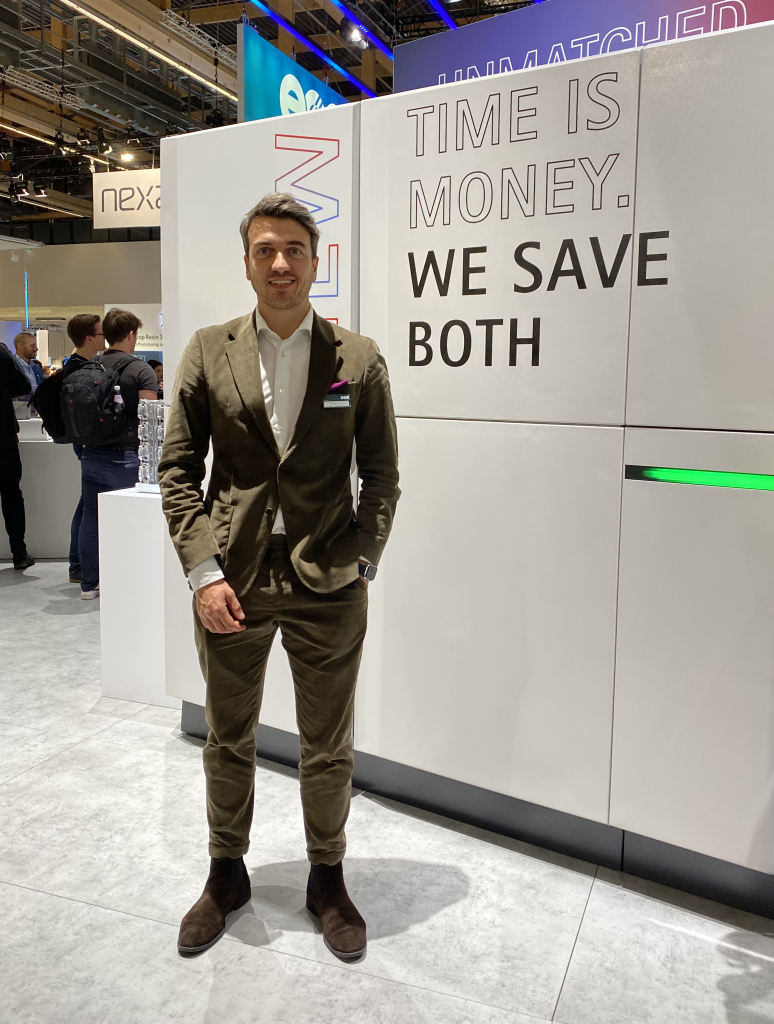
Optimizing cost per part and cutting downtime
Central to the new M 300-4 1kW is its upgraded light engine, which boosts the four lasers from 400W to 1kW. According to Becker, this upgrade has been made to target more applications within die casting, especially for aluminum.
“Where we see challenges at this point in time is in applications with aluminum, especially in aviation and automotive,” explained Becker. “So for us, it was important to find a solution that offers a really attractive cost per part for aluminum.”
Indeed, according to Becker, the high productivity of the M 300-4 1kW ensures that it is a cost effective option for metal 3D printing. “The M 300-4 1kW can 3D print a whole job in 30 to 35 hours. This gives us the ability to come down with cost per part, including operating costs, depreciation of the machine, and consumables like gas.”
Becker stated that the cost per part for the M 300-4 1kW is just 50 cents per cubic meter, independent of the application. EOS hopes that this straightforward will increase the ease at which customers can calculate the costs of their builds. “We are aiming to be more bold on these numbers to easily explain to customers what you can do with this technology,” added Becker.
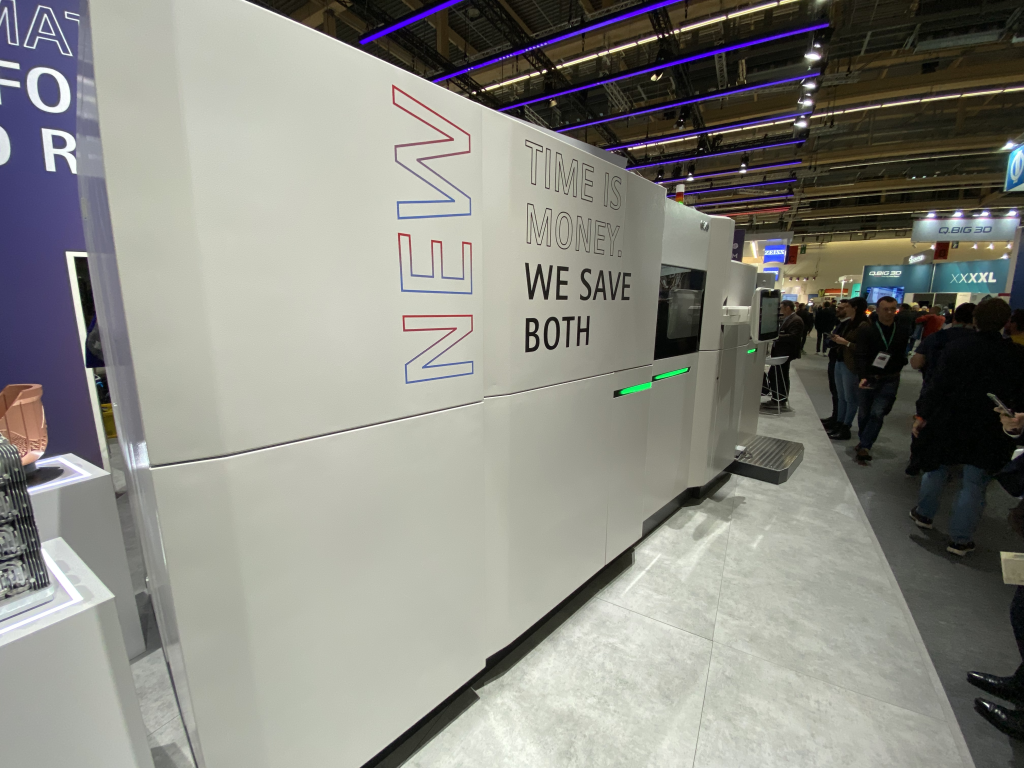
Becker also highlighted reduced downtime as being key to EOS’s newest metal 3D printer, especially with regard to the build job. “Once the build job is done you want to get it out, and you want to get the new one.” To optimize this process, EOS offers the Dual Setup Station.
Developed alongside automation system manufacturer Grenzebach, this station can be used on both M 300-4 and M 400-4 systems to automate the 3D print exchange process. Process steps such as unpacking the build job and removing the residual powder, which are generally performed during 3D printer downtime, can be achieved in parallel to 3D printing.
“The build job is taken out of the process chamber and goes into a parking lot where it can cool down. Whilst that is happening, the second exchangeable frame moves into the process chamber, and automatically starts the next job,” explained Becker. This reportedly allows users to achieve a laser to laser time (the time between job end to job beginning) of 30 minutes, significantly reducing downtime.
This level of automation does not come without its productivity challenges. “The main challenge is that the speed and heat you put into your part, you have to somehow get out. This cooldown time is bad for productivity” explained Becker.
Key to combating this is Smart Fusion, EOS’s proprietary process control software. This platform measures the laser energy absorbed by the powder bed, and automatically adjusts it to reduce temperature where overheating typically occurs.
“Smart Fusion can detect overheating, and then we can react to that by controlling the temperature in the melt pool itself,” stated Becker. “With this, we can reduce support structures.” In fact, Becker claimed that Smart Fusion can reduce support structures by up to 95% and can enable support-free metal 3D printing, reducing material usage and cutting post-processing times.
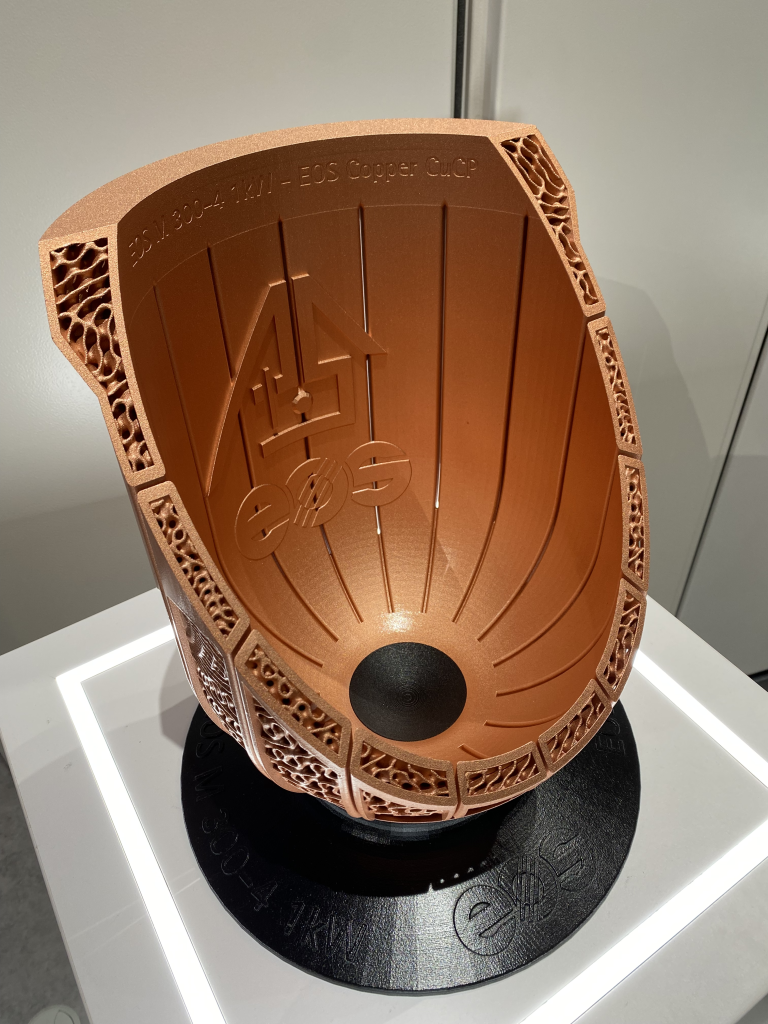
Fitting into the developing metal 3D printing industry
A focus on achieving cost-efficiency with a small number of lasers certainly differentiates EOS from a number of its competitors within the metal additive manufacturing space.
Becker highlighted that there are currently two clear trends in the metal 3D printing space. “The industry is going in the direction of large parts, or it is going into the direction of making parts cheaper.”
On the one hand, companies are looking to offer bigger build volumes beyond 400 x 400 x 400 mm to enable new markets and new applications. Consequently, a bigger build envelope requires more lasers to reach required productivity.
As a result, the past year has seen the development of a “laser war,” with various manufacturers incorporating a growing number of lasers into more expensive metal 3D printers. Last month Chinese 3D printer manufacturer Bright Laser Technologies launched the 20-laser BLT-S800, whilst fellow Chinese company Eplus3D’s new EP-M1550 can incorporate up to 25 lasers. Western companies such as Nikon, SLM Solutions, and Velo3D are also pushing this trend.
According to a Q2 2023 market intelligence report from CONTEXT, these firms are producing more expensive multi-laser 3D printers to ensure revenue growth despite lower 3D printer sales. As such, although powder bed fusion shipments by Western vendors dropped by 5% YoY in H1 2023, revenues grew by 21%.
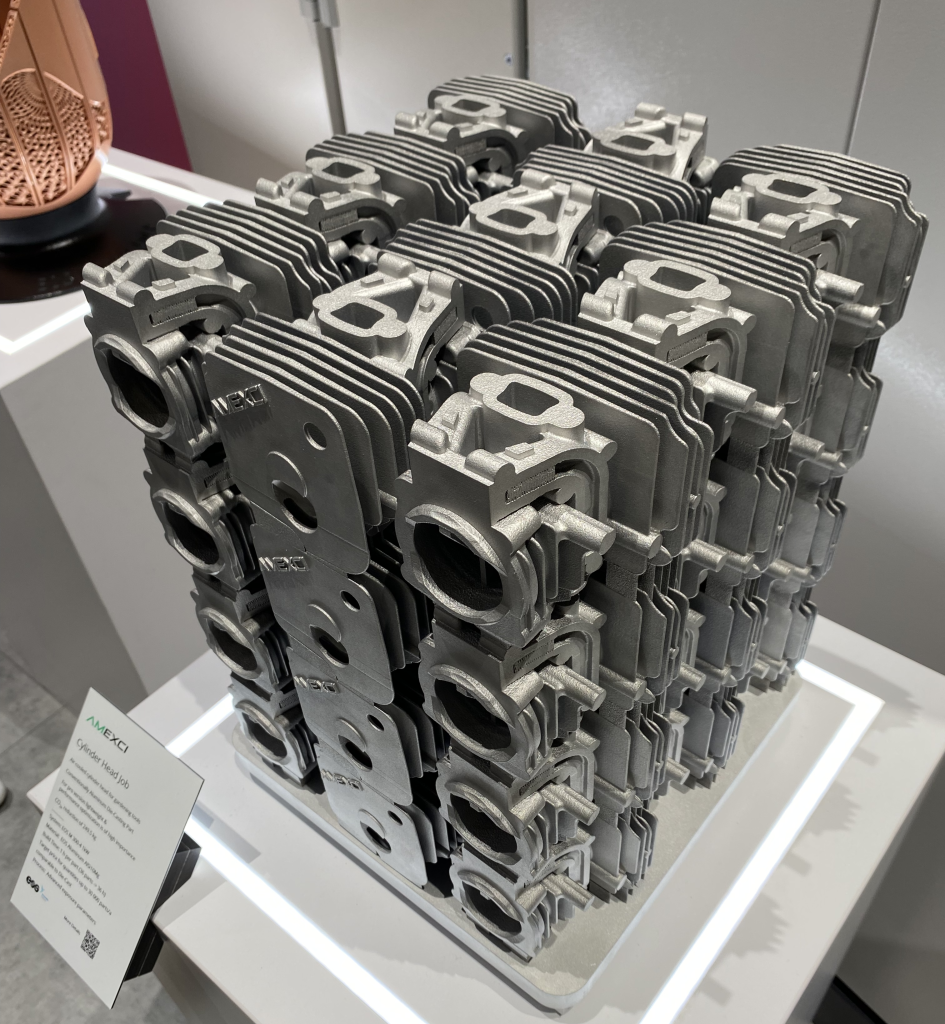
The main focus at EOS, however, “is not to have a machine with 20 lasers which costs around $8 million. It’s about having an affordable substitute for die casting applications.” This feeds into the second theme highlighted by Becker, “enabling new markets and getting better business cases by getting better cost per part.” Becker added that “you cannot get a better cost per part if you are adding 20 lasers. It’s simply not possible.”
Whilst EOS’s new M 300-4 1kW clearly fits into the company’s strategic focus of optimizing cost per part, the company’s affiliate AMCM is capitalizing on the growing demand for large build volumes. The German-based company recently launched its newest metal Laser Beam Powder Bed Fusion (PBF-LB) 3D printer, the AMCM M 8K.
This new 3D printer incorporates eight 1kW lasers and a substantial 800 x 800 x 1200 mm build volume. The development of the M 8K has been aided by a national grant to support aerospace firm ArianeGroup’s Ariane 6 program, a European Space Agency(ESA) project.
“AMCM is doing big, we are doing the more attractive cost per part pathway,” added Becker.
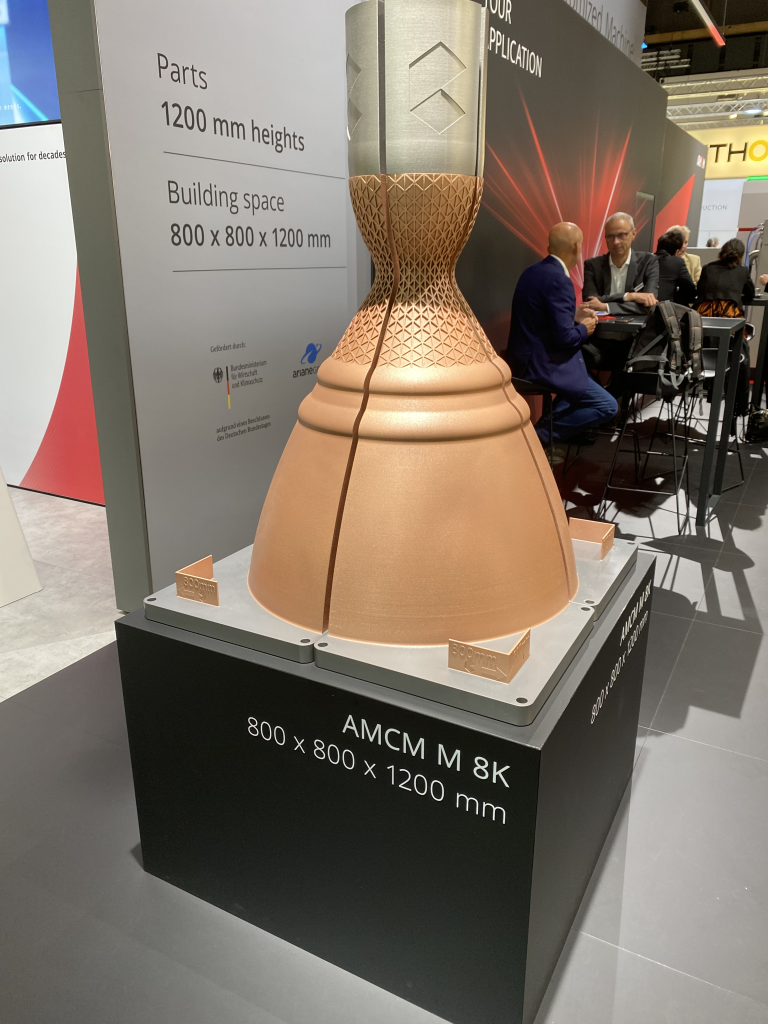
Technical specifications of the M 300-4 1kW
| Construction Volume | 300 x 300 x 400 mm |
| Laser Type | Yb-fiber laser; 4 x 400 W |
| Precision Optics | 4 F-theta-lenses; 4 high-speed scanners |
| Scan Speed | Up to 7.0 m/s (23 ft./sec) |
| Focus Diameter | Approx. 100 µm (0.004 in) |
| Power Supply | 3 x 63 A |
| Power Consumption | Max. 19.6 kW / typical 16 kW |
| Compressed Air Supply | 7,000 hPa; 15 m3/h |
| 3D Printer Dimensions | 5,221 x 2,680 x 2,340 mm |
| Recommended Installation Space | Min. 8,800 x 5,200 x 3,500 mm |
| Software | EOSPRINT 2, EOS ParameterEditor, EOSTATE Monitoring Suite, EOSCONNECT Core, EOSCONNECT Core, EOSCONNECT MachinePark, Materialise Magics Metal Package and modules. |
Subscribe to the 3D Printing Industry newsletter to keep up to date with the latest 3D printing news. You can also follow us on Twitter, like our Facebook page, and subscribe to the 3D Printing Industry Youtube channel to access more exclusive content.
Are you interested in working in the additive manufacturing industry? Visit 3D Printing Jobs to view a selection of available roles and kickstart your career.


